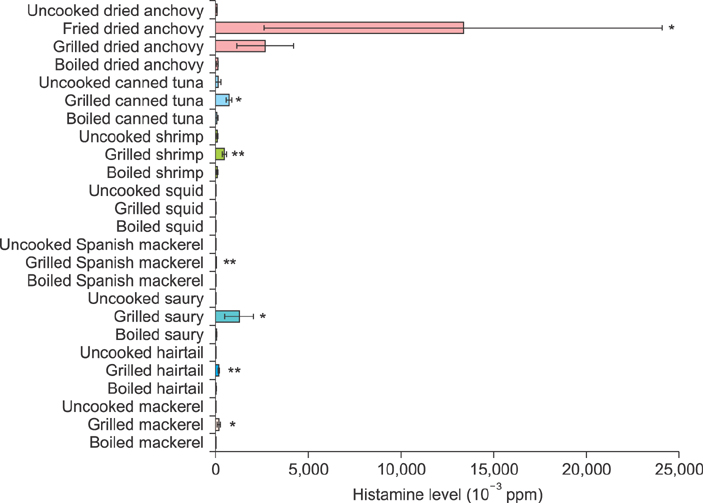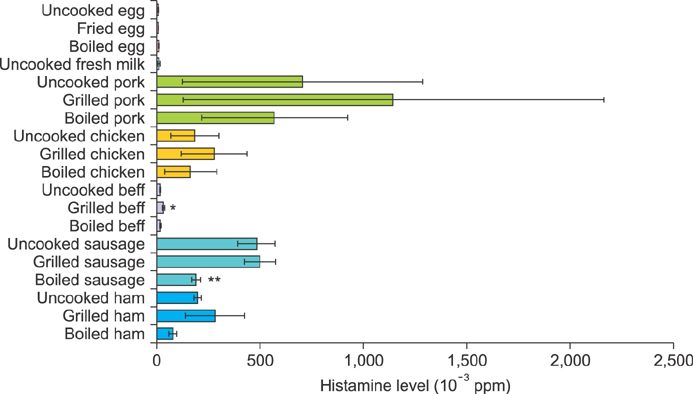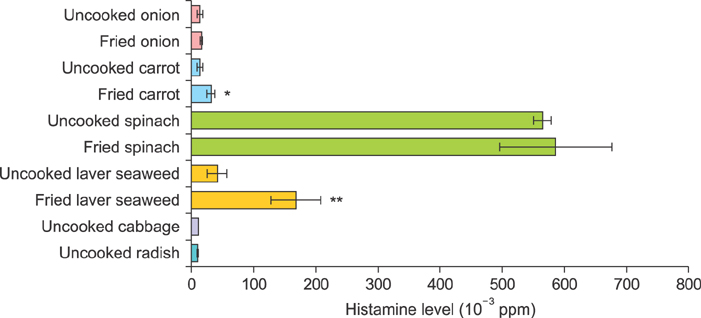Ann Dermatol.
2017 Dec;29(6):706-714. 10.5021/ad.2017.29.6.706.
Effect of Different Cooking Methods on Histamine Levels in Selected Foods
- Affiliations
-
- 1Department of Dermatology, Hallym University Kangnam Sacred Heart Hospital, Hallym University College of Medicine, Seoul, Korea. hyeonekim@gmail.com, dermap@daum.net
- KMID: 2395177
- DOI: http://doi.org/10.5021/ad.2017.29.6.706
Abstract
- BACKGROUND
Histamine in food is known to cause food poisoning and allergic reactions. We usually ingest histamine in cooked food, but there are few studies about the influence of cooking method on the histamine level.
OBJECTIVE
The purpose of this study was to determine the influence of cooking methods on the concentration of histamine in foods.
METHODS
The foods chosen were those kinds consumed frequently and cooked by grilling, boiling, and frying. The histamine level of the food was measured using enzyme-linked immunosorbent assay.
RESULTS
Grilled seafood had higher histamine levels than raw or boiled seafood. For meat, grilling increased the histamine level, whereas boiling decreased it. For eggs, there was not much difference in histamine level according to cooking method. Fried vegetables had higher histamine levels than raw vegetables. And fermented foods didn't show much difference in histamine level after being boiled.
CONCLUSION
The histamine level in food has changed according to the cooking method used to prepare it. Frying and grilling increased histamine level in foods, whereas boiling had little influence or even decreased it. The boiling method might be helpful to control the effect of histamine in histamine-sensitive or susceptible patients, compared with frying and grilling.
Keyword
MeSH Terms
Figure
Cited by 1 articles
-
A Histamine-Free Diet Is Helpful for Treatment of Adult Patients with Chronic Spontaneous Urticaria
Jee Hee Son, Bo Young Chung, Hye One Kim, Chun Wook Park
Ann Dermatol. 2018;30(2):164-172. doi: 10.5021/ad.2018.30.2.164.
Reference
-
1. Fogel WA, Lewinski A, Jochem J. Histamine in food: is there anything to worry about. Biochem Soc Trans. 2007; 35:349–352.
Article2. Bodmer S, Imark C, Kneubühl M. Biogenic amines in foods: histamine and food processing. Inflamm Res. 1999; 48:296–300.
Article3. Taylor SL. Histamine food poisoning: toxicology and clinical aspects. Crit Rev Toxicol. 1986; 17:91–128.
Article4. Taylor SL, Stratton JE, Nordlee JA. Histamine poisoning (scombroid fish poisoning): an allergy-like intoxication. J Toxicol Clin Toxicol. 1989; 27:225–240.
Article5. Maintz L, Novak N. Histamine and histamine intolerance. Am J Clin Nutr. 2007; 85:1185–1196.
Article6. Cho HJ, Cho SI, Kim HO, Park CW, Lee CH. Lack of association of plasma histamine with diamine oxidase in chronic idiopathic urticaria. Ann Dermatol. 2013; 25:189–195.
Article7. Maintz L, Benfadal S, Allam JP, Hagemann T, Fimmers R, Novak N. Evidence for a reduced histamine degradation capacity in a subgroup of patients with atopic eczema. J Allergy Clin Immunol. 2006; 117:1106–1112.
Article8. Maintz L, Schwarzer V, Bieber T, van der Ven K, Novak N. Effects of histamine and diamine oxidase activities on pregnancy: a critical review. Hum Reprod Update. 2008; 14:485–495.
Article9. Ruan P, Gong ZJ, Zhang QR. Changes of plasma D(-)-lactate, diamine oxidase and endotoxin in patients with liver cirrhosis. Hepatobiliary Pancreat Dis Int. 2004; 3:58–61.10. Takimoto Y, Yoshiuchi K, Shimodaira S, Akabayashi A. Diamine oxidase activity levels in anorexia nervosa. Int J Eat Disord. 2014; 47:203–205.
Article11. Honzawa Y, Nakase H, Matsuura M, Chiba T. Clinical significance of serum diamine oxidase activity in inflammatory bowel disease: Importance of evaluation of small intestinal permeability. Inflamm Bowel Dis. 2011; 17:E23–E25.12. Miyoshi J, Miyamoto H, Goji T, Taniguchi T, Tomonari T, Sogabe M, et al. Serum diamine oxidase activity as a predictor of gastrointestinal toxicity and malnutrition due to anticancer drugs. J Gastroenterol Hepatol. 2015; 30:1582–1590.
Article13. Wöhrl S, Hemmer W, Focke M, Rappersberger K, Jarisch R. Histamine intolerance-like symptoms in healthy volunteers after oral provocation with liquid histamine. Allergy Asthma Proc. 2004; 25:305–311.14. Naila A, Flint S, Fletcher G, Bremer P, Meerdink G. Control of biogenic amines in food--existing and emerging approaches. J Food Sci. 2010; 75:R139–R150.
Article15. Wendakoon CN, Sakaguchi M. Inhibition of amino acid decarboxylase activity of Enterobacter aerogenes by active components in spices. J Food Prot. 1995; 58:280–283.
Article16. Nam H, Lee K, Myung C, Rhee J, Lee YC, Hong CS. Analysis on the contents of histamine in Korean foods. Korean J Soc Food Sci. 1996; 12:487–492.17. Choi JH, Park CW, Lee CH. A study of histamine content in food in Korea. Korean J Dermatol. 2007; 45:768–771.18. Diel E, Bayas N, Stibbe A, Müller S, Bott A, Schrimpf D, Diel F. Histamine containing food: Establishment of a German Food Intolerance Databank (NFID). Inflamm Res. 1997; 46:Suppl 1. 87–88.
Article19. Silla Santos MH. Biogenic amines: their importance in foods. Int J Food Microbiol. 1996; 29:213–231.
Article20. Chung BY, Cho SI, Ahn IS, Lee HB, Kim HO, Park CW, et al. Treatment of atopic dermatitis with a low-histamine diet. Ann Dermatol. 2011; 23:Suppl 1. S91–S95.
Article21. Enache E, Kataoka A, Black DG, Weddig L, Hayman M, Bjornsdottir-Butler K. Heat resistance of histamine-producing bacteria in irradiated tuna loins. J Food Prot. 2013; 76:1608–1614.
Article22. Fletcher GC, Summers G, van Veghel PW. Levels of histamine and histamine-producing bacteria in smoked fish from New Zealand markets. J Food Prot. 1998; 61:1064–1070.
Article23. Li L, Wang P, Xu X, Zhou G. Influence of various cooking methods on the concentrations of volatile N-nitrosamines and biogenic amines in dry-cured sausages. J Food Sci. 2012; 77:C560–C565.
Article24. Mavromatis P, Quantick PC. Modification of Niven's medium for the enumeration of histamine-forming bacteria and discussion of the parameters associated with its use. J Food Prot. 2002; 65:546–551.
Article25. Omura Y, Price R, Olcott H. Histamine-forming bacteria isolated from spoiled skipjack tuna and jack mackerel. J Food Sci. 1978; 43:1779–1781.
Article26. Hungerford JM. Scombroid poisoning: a review. Toxicon. 2010; 56:231–243.
Article27. Kung HF, Tsai YH, Wei CI. Histamine and other biogenic amines and histamine-forming bacteria in miso products. Food Chem. 2007; 101:351–356.
Article28. Tsai YH, Kung HF, Lin QL, Hwang JH, Cheng SH, Wei CI, et al. Occurrence of histamine and histamine-forming bacteria in kimchi products in Taiwan. Food Chem. 2005; 90:635–641.
Article29. Lee ME, Jang JY, Lee JH, Park HW, Choi HJ, Kim TW. Starter cultures for kimchi fermentation. J Microbiol Biotechnol. 2015; 25:559–568.
Article30. Jung JY, Lee SH, Jeon CO. Microbial community dynamics during fermentation of doenjang-meju, traditional Korean fermented soybean. Int J Food Microbiol. 2014; 185:112–120.
Article31. Jeon HH, Jung JY, Chun BH, Kim MD, Baek SY, Moon JY, et al. Screening and characterization of potential bacillus starter cultures for fermenting low-salt soybean paste (Doenjang). J Microbiol Biotechnol. 2016; 26:666–674.
Article32. Oh JY, Kim YS, Shin DH. Changes in microorganisms, enzyme activities, and gas formation by the addition of mustard powder on kochujang with different salt concentration. Food Sci Biotechnol. 2006; 15:298–302.33. Cha YS, Kim SR, Yang JA, Back HI, Kim MG, Jung SJ, et al. Kochujang, fermented soybean-based red pepper paste, decreases visceral fat and improves blood lipid profiles in overweight adults. Nutr Metab (Lond). 2013; 10:24.
Article34. Visciano P, Schirone M, Tofalo R, Suzzi G. Histamine poisoning and control measures in fish and fishery products. Front Microbiol. 2014; 5:500.
Article35. Lehane L. Update on histamine fish poisoning. Med J Aust. 2000; 173:149–152.
Article36. Beutling D. Biogenic amines in nutrition. Arch Lebensmittelhyg. 1996; 47:97–102.37. Stratton JE, Hutkins RW, Taylor SL. Biogenic amines in cheese and other fermented foods: a review. J Food Prot. 1991; 54:460–470.
Article38. Lee YC, Lin CM, Huang CY, Huang YL, Chen HC, Huang TC, et al. Determination and frying loss of histamine in striped marlin fillets implicated in a foodborne poisoning. J Food Prot. 2013; 76:860–866.
Article39. Mah JH, Hwang HJ. Effects of food additives on biogenic amine formation in Myeolchi-jeot, a salted and fermented anchovy (Engraulis japonicus). Food Chem. 2009; 114:168–173.
Article40. Roseiro C, Santos C, Sol M, Silva L, Fernandes I. Prevalence of biogenic amines during ripening of a traditional dry fermented pork sausage and its relation to the amount of sodium chloride added. Meat Sci. 2006; 74:557–563.
Article41. López-Sabater EI, Rodríguez-Jerez JJ, Roig-Sagues AX, Mora-Ventura M. Bacteriological quality of tuna fish (Thunnus thynnus) destined for canning: effect of tuna handling on presence of histidine decarboxylase bacteria and histamine level. J Food Prot. 1994; 57:318–323.
Article42. Sattler J, Häfner D, Klotter HJ, Lorenz W, Wagner PK. Food-induced histaminosis as an epidemiological problem: plasma histamine elevation and haemodynamic alterations after oral histamine administration and blockade of diamine oxidase (DAO). Agents Actions. 1988; 23:361–365.
Article43. Tabanelli G, Torriani S, Rossi F, Rizzotti L, Gardini F. Effect of chemico-physical parameters on the histidine decarboxylase (HdcA) enzymatic activity in Streptococcus thermophilus PRI60. J Food Sci. 2012; 77:M231–M237.
Article44. Kanki M, Yoda T, Tsukamoto T, Baba E. Histidine decarboxylases and their role in accumulation of histamine in tuna and dried saury. Appl Environ Microbiol. 2007; 73:1467–1473.
Article45. Roe M, Pinchen H, Church S, Finglas P. Nutrient analysis of eggs. Norwich: Institute of Food Research, Norwich Research Park;2012.46. Vandekerckhove P. Amines in dry fermented sausage. J Food Sci. 1977; 42:283–285.
Article47. Hernández-Jover T, Izquierdo-Pulido M, Veciana-Nogués MT, Mariné-Font A, Vidal-Carou MC. Biogenic amine and polyamine contents in meat and meat products. J Agric Food Chem. 1997; 45:2098–2102.
Article48. Gilbert RJ, Hobbs G, Murray CK, Cruickshank JG, Young SE. Scombrotoxic fish poisoning: features of the first 50 incidents to be reported in Britain (1976-9). Br Med J. 1980; 281:71–72.49. Bjornsdottir-Butler K, Jones JL, Benner RA Jr, Burkhardt W 3rd. Quantification of total and specific gram-negative histamine-producing bacteria species in fish using an MPN real-time PCR method. Food Microbiol. 2011; 28:1284–1292.
Article50. Hongpattarakere T, Buntin N, Nuylert A. Histamine development and bacterial diversity in microbiallychallenged tonggol (Thunnus tonggol) under temperature abuse during canning manufacture. J Food Sci Technol. 2016; 53:245–256.
Article51. Economou V, Brett MM, Papadopoulou C, Frillingos S, Nichols T. Changes in histamine and microbiological analyses in fresh and frozen tuna muscle during temperature abuse. Food Addit Contam. 2007; 24:820–832.
Article52. Rossano R, Mastrangelo L, Ungaro N, Riccio P. Influence of storage temperature and freezing time on histamine level in the European anchovy Engraulis encrasicholus (L., 1758): A study by capillary electrophoresis. J Chromatogr B Analyt Technol Biomed Life Sci. 2006; 830:161–164.
Article53. Sánchez-Guerrero IM, Vidal JB, Escudero AI. Scombroid fish poisoning: a potentially life-threatening allergic-like reaction. J Allergy Clin Immunol. 1997; 100:433–434.
Article
- Full Text Links
- Actions
-
Cited
- CITED
-
- Close
- Share
- Similar articles
-
- Effects of Cooking Activities on the Taste and Perception of Korean Foods among Upper Grade Elementary School Children
- Effects of Fusion-Food Cooking Activity on Elementary School Students' Knowledge, Preferences and Perceptions of Korean Traditional Foods
- Plasma Histamine Levels in Patients with Atopic Dermatitis
- Effect of a Histamine-free Diet in Adult Patients with Atopic Dermatitis
- Effects of HACCP Implementation on an Industry Foodservice Operation in Daegu





